Collector’s Corner: Movie Posters
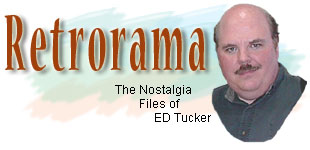
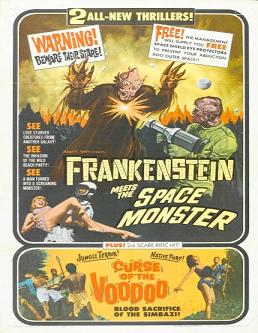
A cool double feature one sheet that proves the best thing about a movie can often be the poster!
Over the last several months I have been approached multiple times by people new to the hobby of collecting movie posters. Some were already avid collectors who just found a new interest while others were new to collecting entirely and just happened to start with their love of movies and the associated advertising memorabilia. Some were old enough to remember movie theaters in their prime and wanted to collect the posters they saw displayed in their youth and others came along more recently and are fascinated by the changes that have taken place in the last twenty or so years where advertising is concerned. Collecting movie posters, like any other form of collecting, is a highly personal process but after spending some time talking to them about the history of this particular avenue of the mania, I felt a primer for the hobby was in order.
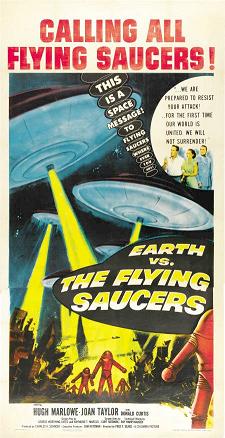
This rare three sheet has different graphics than the one sheet and usually sells for more.
Collecting movie posters has one major distinction over the vast majority of other collectibles. Items like comic books or baseball cards where produced in quantities to supply the general public with an item for entertainment and amusement. Movie posters were printed in considerably smaller numbers to be used as advertising materials at local theaters. As such, there could be as few as one poster created for every hundred issues of a particular comic book or thousand sports cards. In the 1950’s, there were approximately 12,000 indoor theaters nationwide and about 5,000 drive-in theaters. Obviously it was not necessary or cost efficient for studios to produce advertising items in excess of the number of theaters available and not every theater played every film. This makes vintage movie memorabilia much scarcer than its closest collectible counterparts. These advertising items were also not intended for sale to the general public and most carried a disclaimer from the National Screen Service indicating that they were to be returned or destroyed after use. Fortunately most theater managers were frugal individuals and in the days of reissues and revivals, hanging on to older posters could save them some money if the film turned up again.

A beautiful six sheet poster that would take up most of one wall in the average home.
Prior to the 1980’s when movie posters began to be produced in additional numbers for sale to the public, all of the posters that survived to become collectibles went through a theater at one time or another. A small percentage of these posters may have been given away or sold to interested patrons or carted home to their friends and family by theater employees, but most of the ones that were not returned or destroyed ended up folded and stored in boxes in some damp theater basement. As smaller theaters were swallowed up by multiplexes or just run out of business all together, many of these cinematic treasure troves were unceremoniously tossed in dumpsters or plowed under along with the buildings they were stored in. Were it not for a few collectors who were ahead of the curve, not to mention savvy theater employees out to make a quick buck, this hobby would be radically different or might not exist at all.
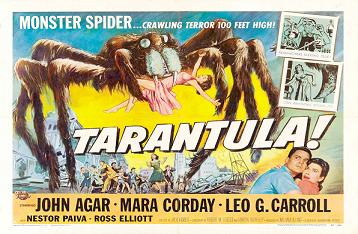
The half sheet for Tarantula is the most appealing piece graphically and usually goes for the most money.
Movie posters were originally produced in a wide variety of shapes and sizes designed to fit the needs of a theater’s size and budget. As time marched on, theaters became more standardized and promotion became less of an art and more of a sideline, everything except the one sheet size was phased out. This eliminated a lot of what makes this hobby interesting as it limited the choices and styles. This makes collecting modern posters an entirely different proposition from older ones and explains why most collectors have so little interest in material from this time. For the purposes of this article, we will concentrate on older US posters. The following is a breakdown of the more common sizes that were available prior to the 1980’s.
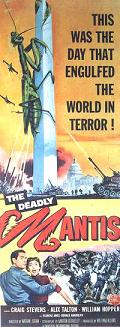
Since the title monster was tall and thin, the insert poster is the nicest piece for The Deadly Mantis.
One Sheet (27” X 41”) – This is the most common size of movie poster. It is the one most theaters used for display above all other types. Movie studios often issued multiple styles of one sheets so it is not unusual to see more than one for a single release of a film. One sheets are printed on a thin paper that folds easily and can usually be restored to a condition that will remove the crease lines if desired. Generally speaking, this is the most popular and most collected style of poster. In the 90’s, the standard one sheet size was changed to 27” X 40” when posters were made available to the public to make them easier to frame. While one sheets were normally shipped to theaters rolled, it is very unusual to find posters from prior to 1980 that have not been folded.
Three Sheet (41” X 81”) – Contrary to the name, three sheet posters typically come in two sections not three although one and three section varieties have been known to exist. This larger style poster was used in bigger theaters and is much less common to find than the one sheet. The paper for these types of posters is similar to the one sheet but slightly heavier. The graphics on a three sheet poster usually follow those of the one sheet closely due to the proportion size but occasionally different styles were used. Due to the size, these posters are not as collectible but may exceed the one sheet in value depending on rarity and graphic variations.
Six Sheet (81” X 81”) – Posters of this size and the even larger twelve sheets were normally used on the exteriors of buildings and billboards. As such they were usually adhered to whatever they were displayed on rather than framed and thus destroyed in the process. Six Sheets are generally only found for films produced from the early 50’s until they fell out of popularity due to single screen theaters drying up in the 70’s. Six sheets are printed on the same type of paper as three sheets. When six sheets do surface today they are usually in mint condition as one that was used was likely not salvageable afterwards. Graphics on a six sheet are often unique to this style and can command a premium price even though they are impractical for the average collector to display.
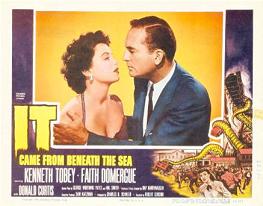
It Came from Beneath the Sea features a giant octopus but only one lobby card in the entire set shows it's image.
Half Sheet (28” X 22”) – Another misnomer in that this poster type is slightly larger than half the size of a one sheet. Half sheet posters are printed on a thick paper stock similar to poster board. They do not respond well to being folded and it is difficult if not impossible to remove fold lines from them. The graphics on a half sheet are often superior to their one sheet counterparts since extraneous images are often reduced and the main image enhanced on the smaller surface area. Even though they are smaller and easier to display than one sheets and considerably rarer, half sheets usually do not have as much value unless their graphics are significantly better.
Insert (14” X 36’) – An insert is essentially a vertical half sheet as though a one sheet were split down the middle length-wise. They are printed on the same type of paper as half sheets, and have a similar rarity and value guidelines. Inserts are usually worth about as much as a half sheet but are not as easily displayed and so not sought out as often by collectors.
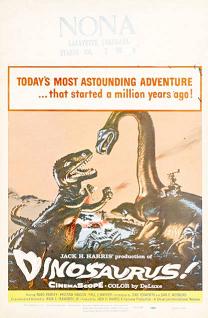
A better than average looking window card for the film Dinosaurus!
Lobby Card (11” X 14”) – While technically considered a type of poster, lobby cards are a collectible unto themselves. They were usually issued in sets of eight and each card featured a different scene from the film. Most lobby cards have border art on one side similar to the graphics on the one sheet and the title of the film prominently displayed. There is normally a number in the bottom border indicating that card’s sequence in the set. Lobby cards were usually printed on a paper slightly thicker than a one sheet and their compact size makes them easy to display either in frames or in albums. Many times a lobby card set will feature a title card that is just the graphics for the film with no image. Title cards are generally more desirable to collectors than scene cards. The value of a lobby card is based on the action or characters featured in the scene and the attractiveness of the boarder art. While a complete set is often preferable, the value of that set can often be only slightly more than a single card from it if one is a key scene and the others are considered dead cards. An example of this would be a horror movie where only one card depicts the monster and the other cards all feature shots of actors talking.
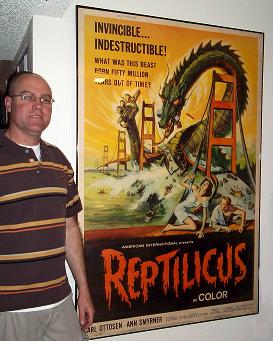
Donovan Johnson poses next to his framed 40 X 60 poster for another film where the graphics are its best feature.
Window Cards (14” X 22) – This was the cheapest type of poster to produce and was intended to stand or be taped in a theater or store window. Window cards are printed on a heavier stock than half sheets or inserts and usually have a blank border area at the top where the name of the theater and play dates could be written. The images on window cards typically follow those of the one sheet but are often printed in reduced or duotone colors to save money and make them cheaper to produce in bulk. Companies like Benton Brothers were the major manufactures of these cards. In the early 90’s, warehouses full of unused window cards were found and released to the public at discounted prices. The market has since stabilized but due to this influx and the inferior graphics and printing process, window cards are usually valued at only a fraction of the one sheet price.
Other Sizes – The poster sizes listed above are the ones most typically found for sale but there are many other unconventional or less popular sizes. A 30” X 40” poster is almost identical to a one sheet but printed on heavier stock and with a wider blank border surrounding the image. These were printed for special types of frames found in public areas. The 40 X 60 poster, sometimes referred to as a subway poster because they were most often used in mass transit stations, is printed on a similarly heavy stock and may or may not have the same graphics as a one sheet. Both the 30” X 40” and 40” X 60” styles of posters are rare because of their original limited usefulness but can often still be found in unused rolled condition. If either of these types were folded for storage, the fold lines are almost impossible to remove due to the thickness of the paper. There are also several variations in the sizes of window cards and lobby cards and even some non-standard one sheets depending on whether they were printed by a company that specialized in posters or not. Posters of these sizes turn up infrequently and are typically valued based on the uniqueness of their graphics and condition.
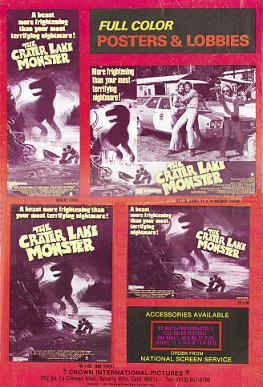
The back page of the pressbook for Crater Lake Monster displays the various posters available to advertise the film.
Pressbooks – One last item worth mentioning for poster collecting isn’t even a poster but it does represent advertising memorabilia. Pressbooks were large pamphlets ranging anywhere from four to twenty plus pages that were sent to theaters to announce the release of a film. They typically contain a plot synopsis of the movie, biographies on the cast and crew, and suggested promotional tie-ins. They are of critical importance to poster collectors because they usually listed the various types of posters that were created for a film and showed examples of most of the styles to help the theater manager decide what items to order. Pressbooks usually have the least value monetarily of promotional materials related to a film but they can have the greatest historical value.
Starting a movie poster collection can be as easy or as difficult as the person doing the collecting wants to make it but it can be done on almost any budget. Most people start with the films that they enjoy watching which is great if you have unusual tastes but most blockbuster movies from before 1980 can command some serious prices. If the titles you are looking for are the more expensive ones, you can try specializing in smaller or odd sized items that may sell for less than the one sheets most collectors consider to be the key pieces. Sometimes studio films were released with several different one sheet styles including advanced and re-releases. Often only one or two of these posters will prove extremely popular or rare and the others can be picked up at a reasonable price. The more narrow your collecting scope, the easier it will be to stay on budget but you will have to discipline yourself to make fewer purchases of higher quality.
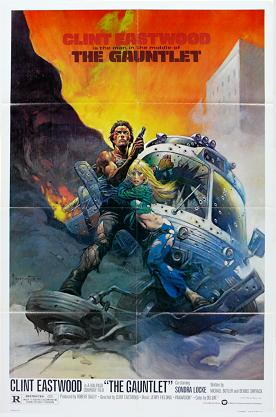
A 40 X 60 poster showcasing the Frank Frazetta artwork for Clint Eastwood's The Gauntlet.
Finding vintage movie posters is much easier today than it has ever been in the past thanks to the Internet and online sales. Prior to this technological advancement, poster collectors had to rely on specialty shops that were few and far between, mail order companies, or, if they were lucky, an inside source at their local cinema. Today, if your pockets are deep enough, you can probably purchase 90% of anything you can imagine online at any given moment. This is, again, where narrowing your scope and sticking to a budget can be your greatest resources, especially if you may wish to resell at some point.
Condition plays a major role in the value of movie memorabilia but it should not be considered a limiting factor for vintage items. Because of the underlying rarity movie posters, some wear is expected in almost every surviving piece and it can actually ad character. For example, if you have a window card in your collection with the name of a theater written in the white margin, this may detract slightly from the value of one without this but it makes yours a more interesting display piece. The older the piece of movie memorabilia being considered, the more skeptical a potential buyer should be of anything exhibiting little to no wear.
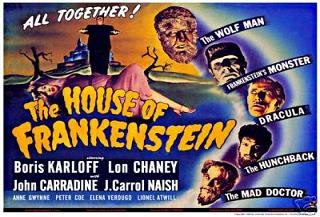
An extremely rare title card for Universal's House of Frankenstein.
One negative side effect of the wide availability of movie posters the Internet has provided is the massive influx of reproductions that have flooded the market in the last few years. The majority of these are made in contrasting sizes that make their origins obvious but some are nearly identical to the originals they were copied from. Most dealers, especially those who desire repeat customers, will clearly mark reproductions if they carry them at all. Collectors should still be weary of any poster that appears to be priced much lower than it would normally be expected sell for, especially if it is in exceptional condition. It is almost impossible to find any one sheet posters from before 1980 that have not been folded (reproductions often have fold lines printed into them from the source image) so if something looks too good to be true it probably is.
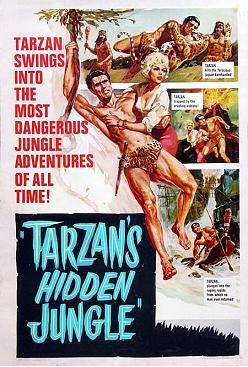
A 30 X 40 Tarzan poster. Note the wider white border area.
Like any other area of collecting, a person’s tastes in posters can change over time and they may wish to modify their scope or head off in new directions. This leads to some impressive items finding their way back onto the market when a collector decides to change his focus, retire from the hobby completely, or recoup some of his investment. There are many auction houses now that have specialty auctions specifically for posters and movie memorabilia that will usually accept higher end items on consignment. Online auction services may be a better option for lesser material or for a quicker turnover but in either case, plan on approximately 30% of your sales price going to pay for various fees related to the auction. Collectors with enough contacts in the collecting community can do better by just circulating a list among the people they know. If you live in a larger area that has some collectibles shows, a table there could pay for itself in a matter of hours depending on the quality and quantity of what you have to sell.
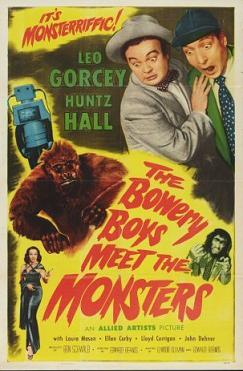
A three sheet for one of the most popular Bowery Boys films that is also one of their most valuable posters.
Another hot topic for movie poster collectors is how to display their collection. Posters obviously lend themselves to being framed and hung on walls but the average home only has so much available space. The nice thing about posters being standard sizes for the most part is that it is easy to swap them out and change the entire theme of a room with very little effort. It is strongly advised that framed posters not be dry mounted or physically attached to the frame in any way. Make sure posters slide into an out of the frames easily to avoid damage as this can seriously impact their value. For posters not being displayed there is acid free cardboard backings and Mylar bags for almost any size and they make locating a particular item very easy. At the very least, stored posters should be in plastic bags, even if folded or rolled, to prevent dust, moisture, or insects from damaging them.
The greatest piece of advice I can give to any collector is to clearly define what you want to collect and do everything you can to educate yourself on this material BEFORE you get started making purchases. A quick search of the Internet can produce all types of information on poster collecting so try to be specific on what you are trying to find. Because movie poster prices can be so high and varied, it is very easy to make mistakes when you are new to the hobby. Even the most experienced of collectors can make a rash or ill informed decision in the heat of a purchase when they think they have found something particularly rare only to find out a few hours later it is a different, more common issue. Have fun and happy collecting!
Special thanks to Donovan “The Poster Man” Johnson for his insight and input in the creation of this article.
